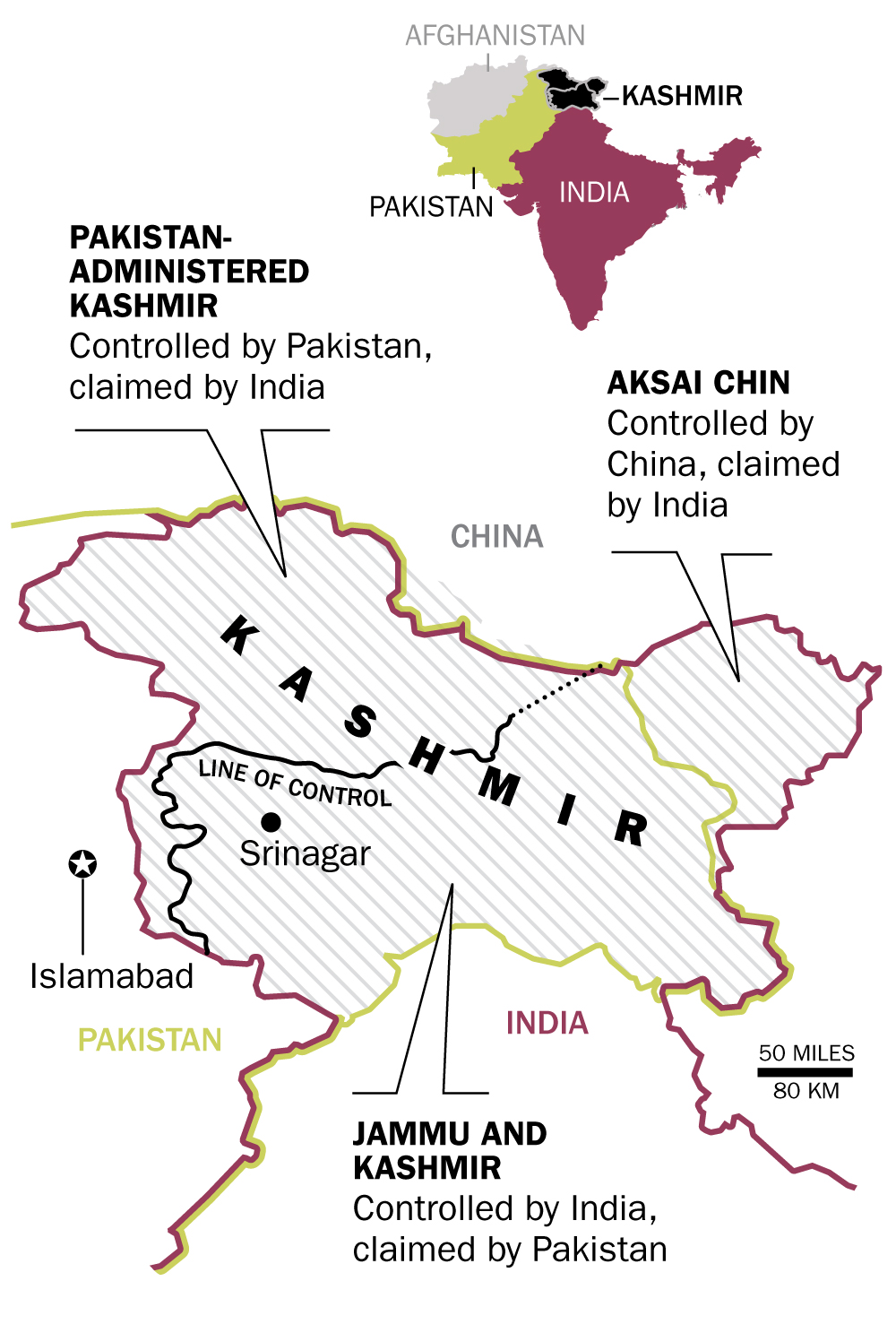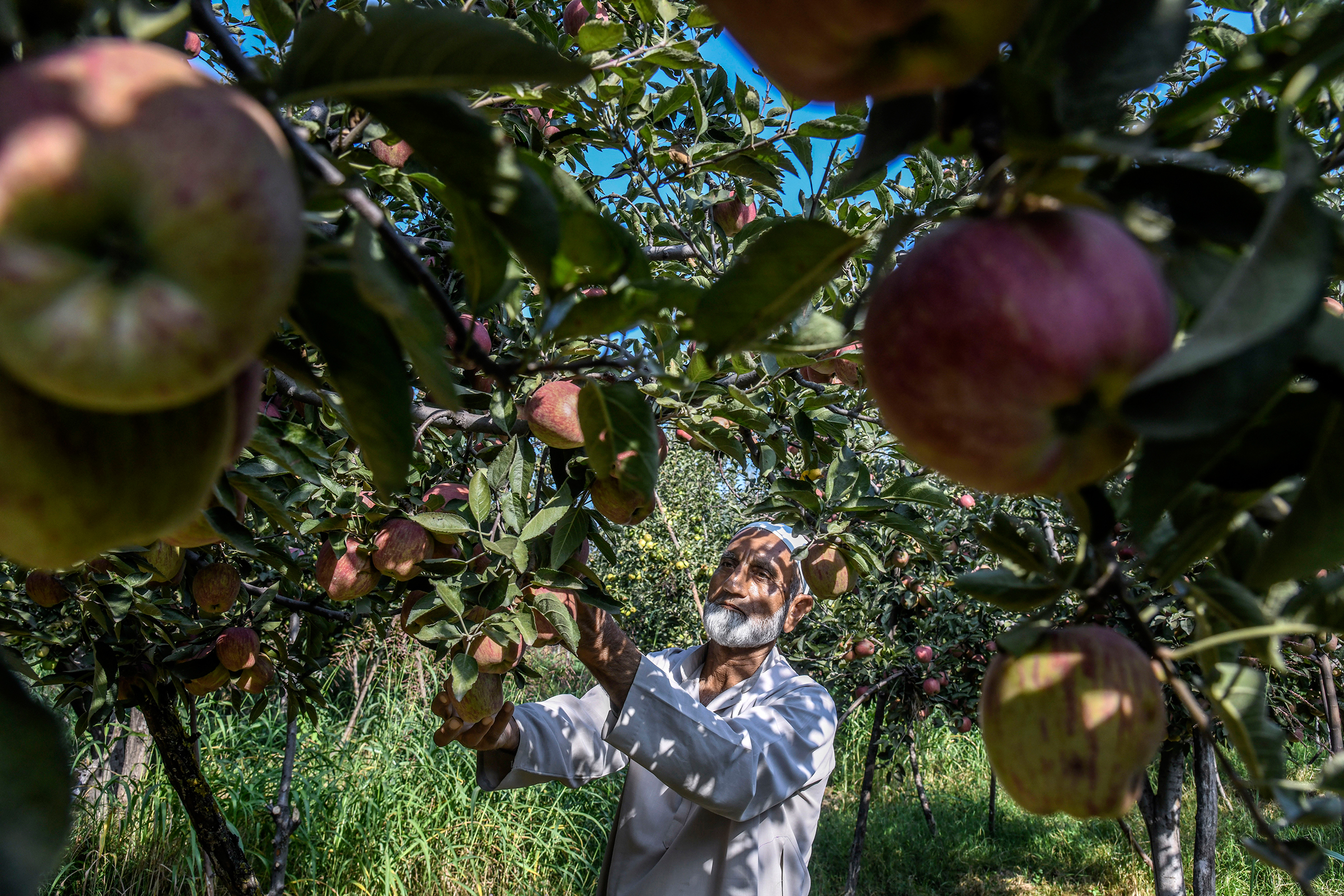It’s apple season in Kashmir, but in orchards across the fertile Himalayan valley, unpicked fruit rots on the branches. Markets lack their usual bustle, most shops are open for only a few hours each morning, and schools and colleges are largely empty of students.
The slowdown reflects both the firm grip of the Indian government on the Muslim-majority state, and the seemingly spontaneous reaction of the Kashmiri people to it. A tweet posted on the account of Mehbooba Mufti, the state’s former Chief Minister who has been detained for more than two months, read: “Kashmiris have been resolute about a civil curfew as a mark of protest.”
It was Aug. 5 that Prime Minister Narendra Modi’s Hindu nationalist government said it would scrap the semi-autonomous status that the state of Jammu and Kashmir had held under India’s constitution for seven decades. For the next 72 days, the Kashmir Valley and parts of Jammu endured a communications blackout, with landlines, cell phones and the Internet suspended. “Nine to 10 million people were pushed behind an iron wall. We’d never seen anything like this,” says Anuradha Bhasin, the executive editor of the Kashmir Times, citing previous Internet blackouts that still left phone services intact. “There was an absolute silence.” Already one of the world’s most militarized regions, the Valley was flooded with tens of thousands of Indian troops.
If the heavy-handed measures of the curfew were intended to dampen the threat of violence, they succeeded—at least for a time. But now that India has begun lifting restrictions on the Valley, Kashmiris are bracing themselves for what happens once the clampdown is over. In a Sept. 29 column, former Indian Supreme Court Judge Markandey Katju wrote that Kashmir would become India’s Vietnam War, a nightmare with “body bags” returning in large numbers. “Remove the restrictions, and popular protests will engulf the whole Valley. Continue them, and the pot will boil until it explodes.”

The problems in Kashmir have been shaped by colonial history, religious tensions and nationalism. During the Partition of British India in 1947, the leader of Jammu and Kashmir pushed for independence rather than choosing to join Muslim-majority Pakistan or Hindu-majority India. When Pakistan tried to take the territory anyway, Kashmir’s leader asked for help from India, which agreed—on the condition that Kashmir accede to India. What followed was the first of two wars that Pakistan and Hindu-majority India fought over Kashmir. Today, both of the nuclear-armed countries claim the state as a whole; India controls roughly half the land, Pakistan controls less than a third and China the rest.
In the past three decades, Pakistan has also partially backed and funded insurgents in Kashmir, where the Indian government has responded with troops and often brutal tactics. A U.N. report in July raised concerns about serious abuses by Indian forces, including extrajudicial killings, torture and pellet-gun blindings. New Delhi dismissed the report as a “false and motivated narrative.”
Repealing Article 370 of the Indian constitution—which gave Kashmir autonomy in all areas except foreign affairs, defense and communications-—was a long-standing goal of Modi’s party, which sees India as a Hindu nation and long opposed rules preventing outsiders from buying land in Kashmir. Stripping the special status has seemed to rouse the party base. “For 70 years, Article 370 was proving to be an impediment in the way of the spirit of ‘one country, one constitution,’” Modi said to cheers during a rally in Maharashtra ahead of local Oct. 21 elections.
Read more: India has taken Kashmir, but winning the hearts and minds of Kashmiris will be harder
To Pakistan, the situation looks rather different. “The red line has been crossed on Aug. 5,” says Masood Khan, president of Azad (Free) Kashmir, one of two territories in Kashmir administered by Pakistan. A career diplomat who worked in Washington and Geneva as part of Pakistan’s permanent mission to the U.N., Khan grew up in Azad Kashmir and describes himself as a “son of the soil.” On a recent trip to Washington D.C., he urged the international community to intervene and start talks with India. “We’re in a state of war,” he told TIME.
But while the rhetoric on both sides remains hostile, Pakistan can ill afford a full-scale conflict, analysts say. On Oct. 18, the Financial Action Task Force, the global terrorism finance watchdog, ruled Pakistan would stay on its “greylist”until February 2020 as it was doing too little to tackle its funding of violent extremism. Pakistan was also bailed out by the IMF this summer for the 13th time in 30 years, inflation is predicted to surge, and the World Bank recently cut its economic growth forecast. “There’s a realization that without an economy, Pakistan is not going to have a military,” says Gareth Price, senior research fellow at the London think tank Chatham House.
A greater security risk seems to be the anger and resentment simmering within the Valley. Nearly 4,000 people, including politicians, activists, journalists, have been arrested, according to a Sept. 6 government report seen by Reuters, and thousands remain in custody. On Sept. 24, the National Federation of Indian Women highlighted claims that 13,000 boys had been picked up and detained, some for up to 45 days. “These incidents instill a fear that goes very deep,” Bhasin says. “Kashmir is not a monolith; there will be a creative response, a peaceful response—and a violent response.”
A rise in homegrown terrorism in the Valley now seems almost inevitable, Khan suggests. “There’s lots of anger there. It is sharp and fierce,” he says. “But when people are defending their homes against Indian attacks, we don’t call it militancy. We would call them freedom fighters.”
Violence has already risen as India dismantles the “iron wall” in Kashmir. Cell phone services were restored on Oct. 14 (the Internet is still restricted), but peaceful protesters are still being arrested. On Oct. 16, five were killed: two civilians in attacks by suspected militants, and three alleged rebels, by Indian forces. Four days later, shelling on both sides of the boundary between India-adminstered Kashmir and Pakistan-administered Kashmir led to the deaths of at least nine soldiers and civilians.

The repeal of Article 370 “opens the door to rejuvenate a moribund economy,” the Indian ambassador to the U.S. wrote in a September New York Times column. But the clampdown has hit hard; the Kashmir Chamber of Commerce and Industry estimates it shutdown has already cost the region over $1.4 billion. Although tourists are now allowed in, the precarious security situation means the tourism and handicrafts sectors are unlikely to bounce back fast. Classes have not resumed at many schools and colleges. “We are helpless. I want to teach, but I can’t teach,” says a 46-year-old professor, who asked for anonymity out of safety concerns. “For some, it feels criminal to go to school and study because there’s so much anger and resentment.”
For journalists, the shutdown was particularly difficult. “We were forced to work in ways that took us back 50 years; we were working like stenographers,” Bhasin says. “The government set up a media facilitation center that was open for a few hours a day. There was one mobile phone and three computers available for over 100 journalists to operate.” Bhasin filed a petition to the Supreme Court on Aug. 10 to immediately relax the “virtual blackout” on communications and to ease the restrictions of the free movement of journalists. “The case is still pending,” she tells TIME more than 10 weeks later, “It has been bumped from one hearing to another. This was an issue that required immediate attention.”
And Kashmir’s $1.5 billion apple trade, which employs more than 3 million people, suffered during the blackout, which cut traders off from buyers. Now, militants are targeting apple sellers, pickers and drivers; within three days in October, two people were shot and another injured in two separate insurgent attacks on the apple trade.
Yet the violence in the Valley hardly represents a significant escalation, says Ajai Sahni, executive director of the Institute for Conflict Management in New Delhi. “Kashmir has been a theater of terrorism for over 30 years, and the idea that the government’s recent moves were going to bring violence to an abrupt and sustainable end was visibly absurd,” he says. Ultimately a long-term political solution is needed, he adds, one that allows the Kashmiri people to address their grievances.
On Oct. 11, the state government took out a full-page ad on the front page of the newspaper, Greater Kashmir. “CLOSED SHOPS, NO PUBLIC TRANSPORT? WHO BENEFITS? Are we going to succumb to militants? Think!!!” it pleaded. But most Kashmiris are not returning to business as usual, either too afraid of violence or determined to disobey New Delhi. “There’s a collective sense of fear, humiliation, hurt and anger,” Bhasin says. “The natural fallout is that this will erupt in different forms. The only question is when.”
—With reporting by Sanya Mansoor/New York
More Must-Reads from TIME
- Caitlin Clark Is TIME's 2024 Athlete of the Year
- Where Trump 2.0 Will Differ From 1.0
- Is Intermittent Fasting Good or Bad for You?
- The 100 Must-Read Books of 2024
- Column: If Optimism Feels Ridiculous Now, Try Hope
- The Future of Climate Action Is Trade Policy
- FX’s Say Nothing Is the Must-Watch Political Thriller of 2024
- Merle Bombardieri Is Helping People Make the Baby Decision
Write to Naina Bajekal at naina.bajekal@time.com